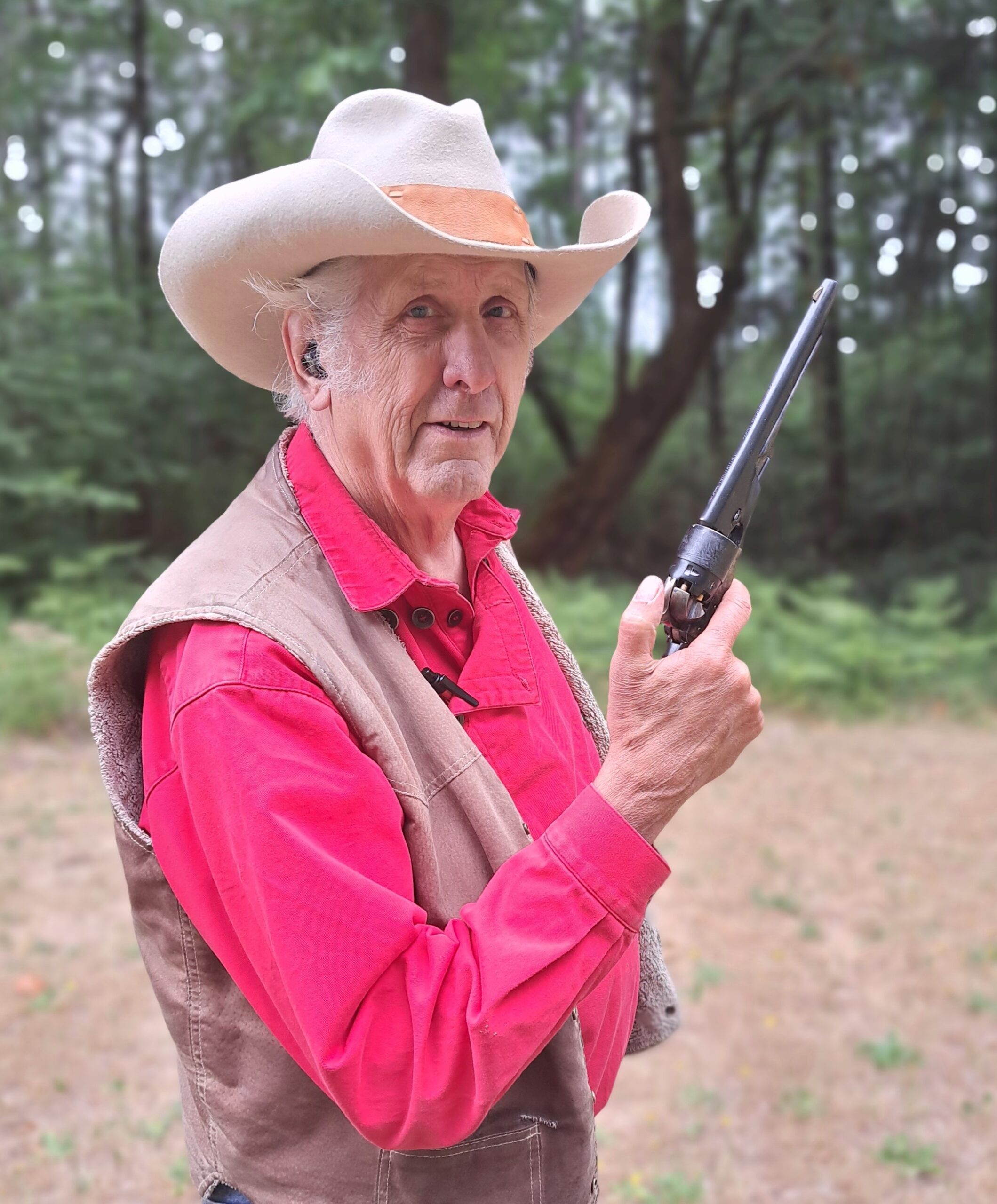
By Mike Nesbitt | Contributing Editor
The movie “Quigley Down Under,” from 33 years ago certainly put the Model 1874 Sharps rifle in the spotlight but it also put the 1860 Colt .44 Army revolver in the center of attention, at least in a couple of scenes.
The final gunfight in the movie is one of those scenes; an outstanding one with Tom Selleck’s Matthew Quigley saying, “This ain’t Dodge City, and you ain’t Bill Hickok.” What followed was an excellent example of very successful and accurate fanning with the old Model 1860 Colt.
Well, that did add action to the movie but I’m not about to recommend copying such doin’s like fanning or that it should be even tried. However, those outstanding scenes did cast a spell of “the wants” in me for a good replica of the 1860 Colt, simply for some enjoyable cap and ball shooting. And while “looking around” on vendors’ row at the Matthew Quigley Buffalo Rifle Match this year, I found one.
This gun I found is not an Italian replica, but one of the very early imported replicas for Centennial Arms, which were made in Belgium. Whether those are any better than the Italian guns I won’t say, although that was the belief years ago when the Italian replicas began to arrive in this country, which takes us back to about the mid-1900s.
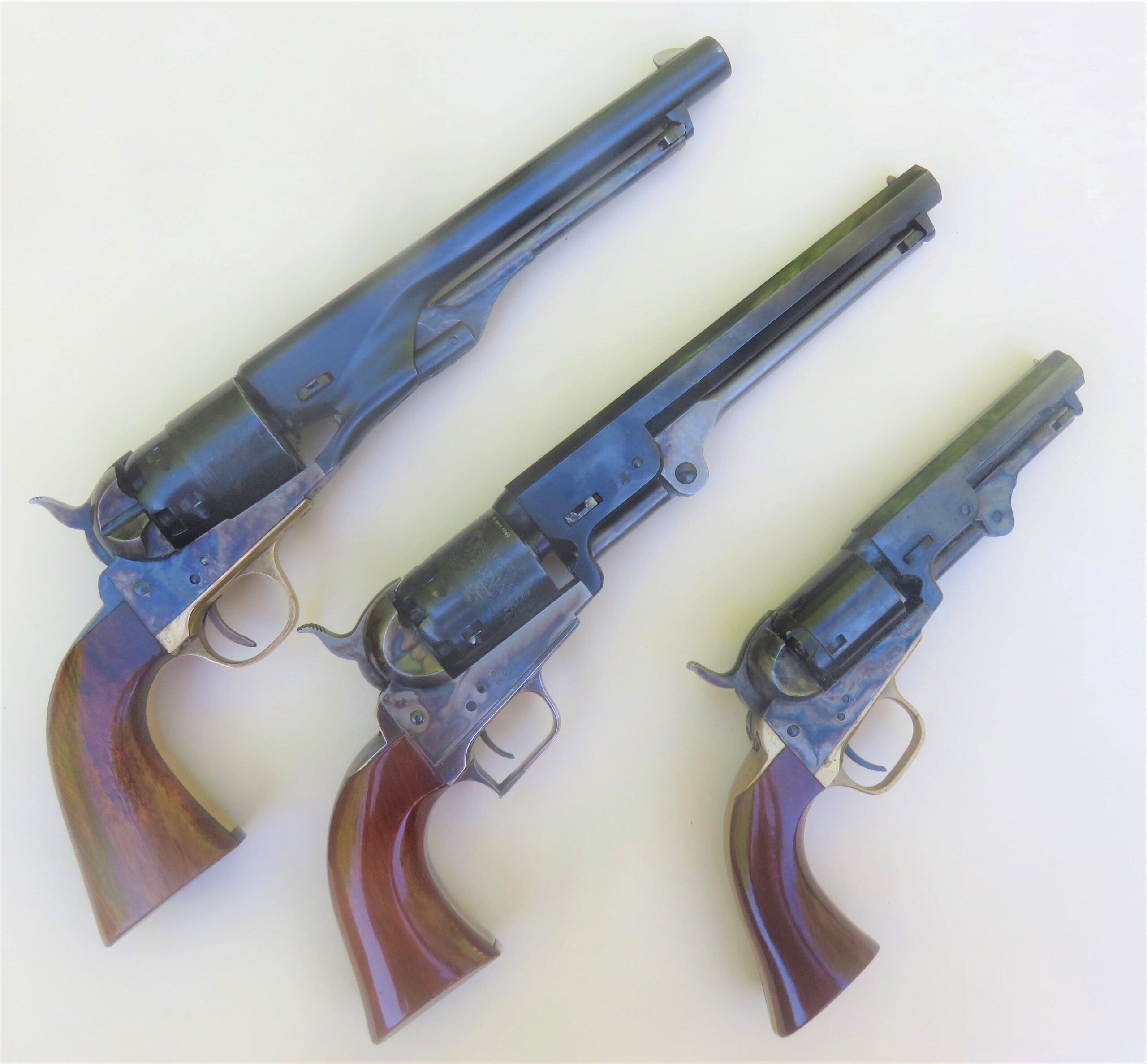
Finding that gun at the big Quigley Buffalo Rifle Match did add to the overall experience but there was more. What was more significant was the revolver’s serial number: 4477. The old .44-77 Sharps is one of my favorite black powder cartridges and that made this revolver “fit in” even greater. So, with just a little haggling, this sixgun became mine and I took it back to the tent where my partners and I were camped. Nothing more was done with it until getting back home.
There is one outstanding feature about the 1860 Army that I personally favor and that’s the size of the grip. The 1860’s frame is the same size as the 1851 Navy’s, with the cylinder rebated so it can accept the .44 caliber chambers and the forward part of the frame relieved to accept the wider-mouthed cylinder, so the gun is not noticeably heavier. Even so, the Army’s grip is longer than that of the Navy model which allows a firmer hold on the gun. While I haven’t used an 1860 Army in several years, I have been using a Richards-Mason conversion in .44 Colt fairly recently which has the same size comfortable grip.
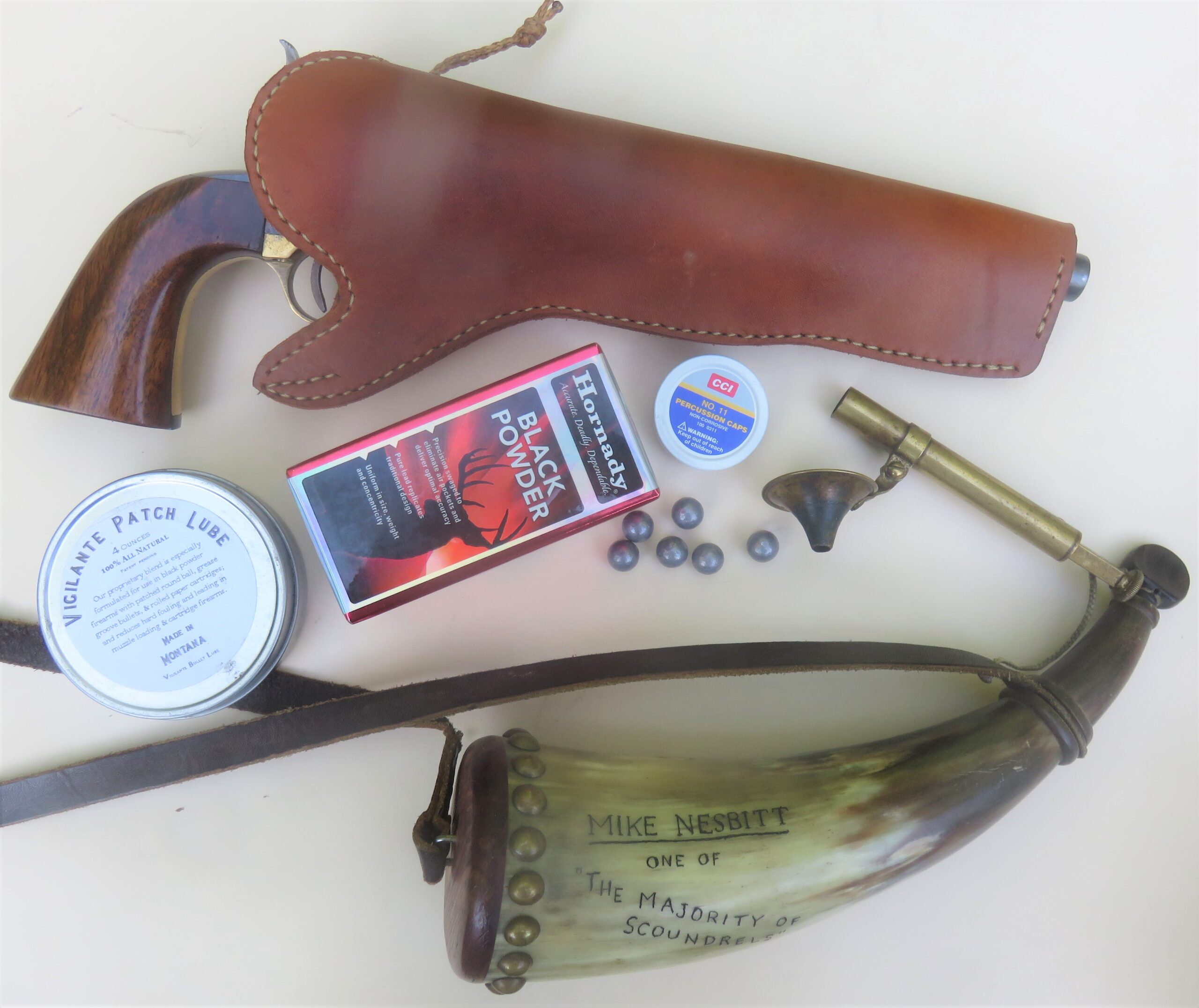
After using an 1860 or one of the conversions for a while, when you go back to a Navy model or the Peacemaker, you’ll feel like something is missing in the grip. That’s because the grip on the Army is roughly 3/8” longer than the Navy’s or the Peacemaker, carefully measured with my yardstick. On the Army, the little finger of my shooting hand can fully engage the grip but on the Navy or a Peacemaker it can’t. To summarize this simply, the grip on the Army allows for a little more control.
Actually, the grips on all Colt percussion revolvers are rather comfortable, including the Navy and the 1849 Pocket Model. The grips on each of those guns have their strong points and, perhaps, some weaknesses. I really can’t say that I like one over the others, those grips need to be teamed with the revolver they’re attached to before further comment can be made. In other words, I like the Army grip on the Army and the Navy grip on the Navy. The same goes for the grip on the 1849, it fits with the rest of the gun, as do the others.
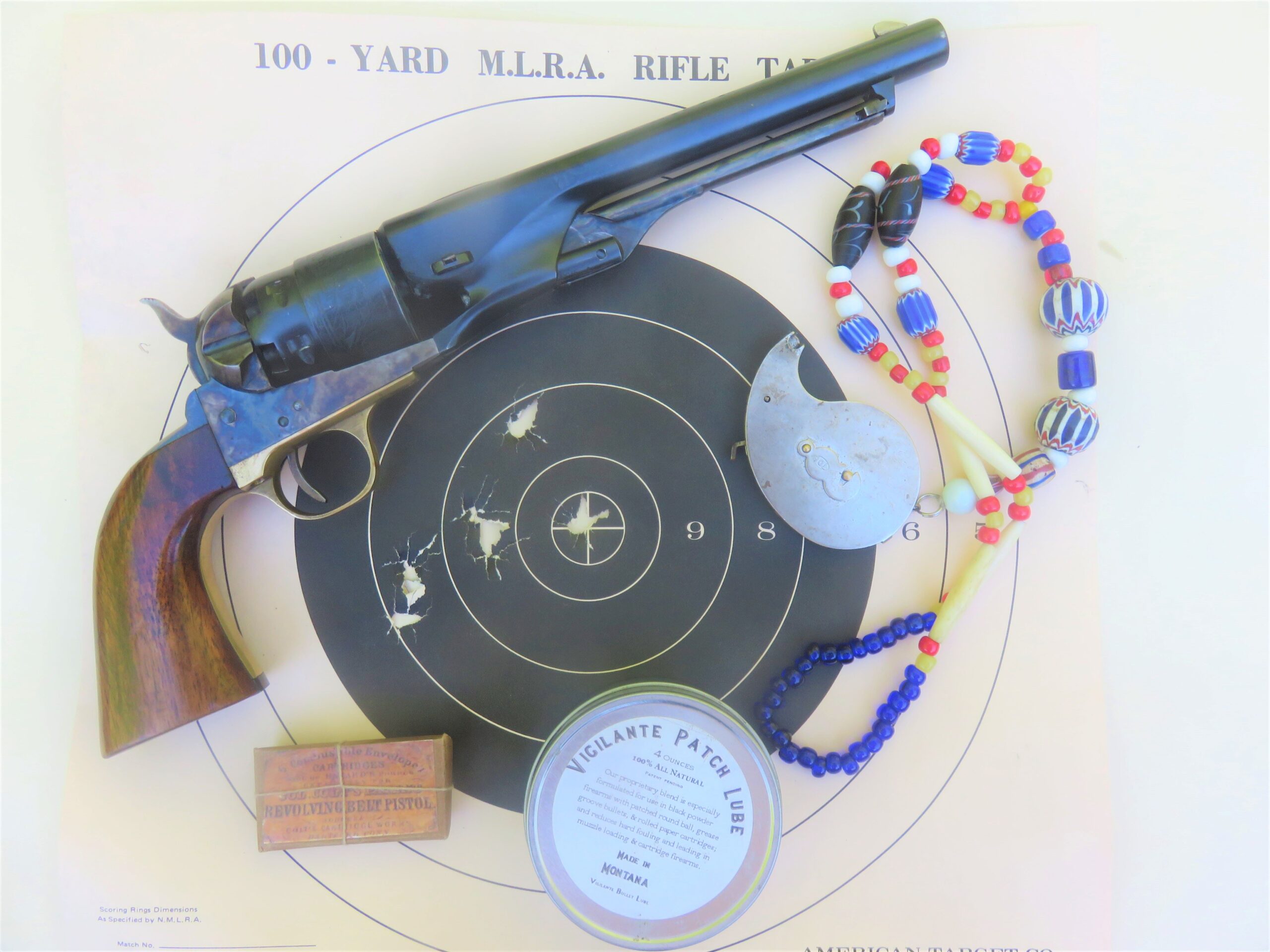
Of course, shooting the revolvers is where we’d make the real test and this new-to-me 1860 Army has done some good shooting. To prepare for some shooting trials, bullets were bought, cast, and obtained in paper cartridges. The swaged round balls from Hornady were tried in .451” diameter and some round balls of the same size were cast from a Lyman bullet mold. The paper cartridge from Buffalo Arms Company were assembled with .454” round balls and a little will be said about all of those.
Caps and Cartridges
To begin with, caps were snapped on each of the nipples before attempting to load the chambers in the cylinder. Snapping those caps simply clears any oils out of the nipples. And my favorite CCI #11 percussion caps were used. After those caps were snapped, the loading could continue.
The paper cartridges from Buffalo Arms Company weren’t tried at first but they were the best, so we’ll talk about them first. Buffalo Arms, or BACO as they are known, sells paper cartridges in two sizes, for .36 caliber and .44 caliber revolvers. I used their .36 caliber cartridges a while back in the .36 Navy. Those used a .375” swaged ball over 14 grains of FFFg powder, which allows them to be used in the .36 caliber pocket models as well as in the Navy models. And they are advertised as obtaining a velocity of 691 feet per second out of a 7 ½” barrel. (They got that velocity from me, that’s okay, we can share information.)
Shooting the paper cartridges in the .44 Army was a real blast, to say the least. These have twice the powder that was used in the .36 caliber cartridges, 28 grains of FFFg. The bullets are swaged round .454” balls, which should weigh in at 148 grains. One box of six of those cartridges was fired, just one cylinder full, at a paper target posted at 30 feet. That was the “hottest” load I have fired in this 1860, so far, and it hit very well, right where it was aimed. I could easily say that I wish all of the loads I tried would shoot like that but, honestly, I’m not through trying various loads as yet.
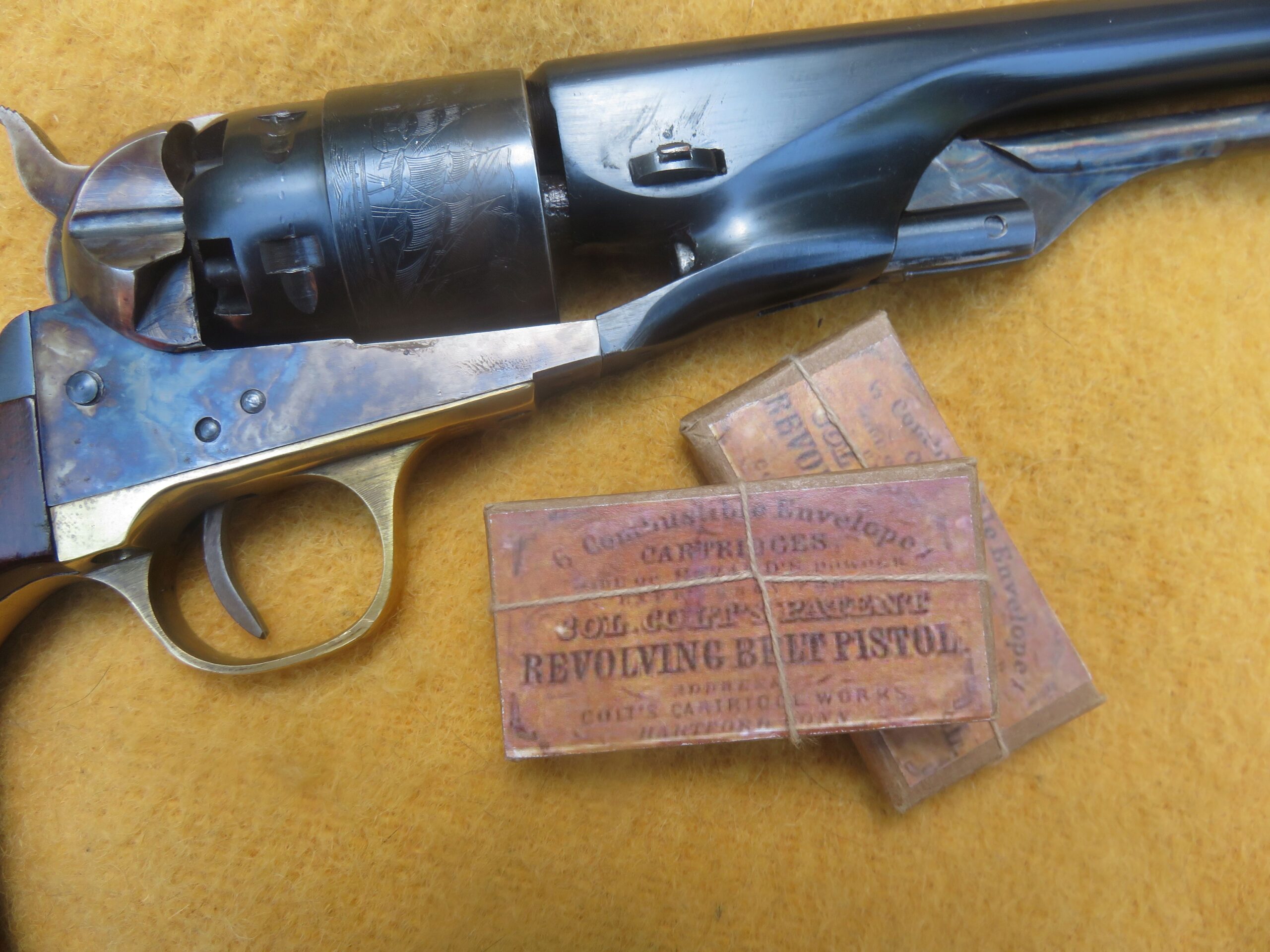
Once more; Buffalo Arms Company offers these combustible paper cartridges only for revolvers and they are priced at $14.99 per box of six. A small savings can be enjoyed by purchasing more than one box. Once hooked on shooting the paper cartridges, Buffalo Arms also offers the nitrated papers so shooters can “roll their own.” To place an order, take a look on their web site at www.buffaloarms.com. Or contact them at Buffalo Arms Company, 600 Vermeer Court, Ponderay, Idaho 83852, phone 208-263-6953.
The small cardboard cartridge box or wrapper that BACO puts those paper or combustible cartridges in is somewhat of a collector’s item all by itself. For the .44 caliber paper cartridges, each packet of six cartridges is wrapped and tied with twine which, in addition to the old-style label, gives the pack of cartridges a certain “old time” flavor. Loading those paper cartridges was very easy and ramming the .454” round balls into the gun’s chambers was not hard at all. Those balls must be very soft or pure lead. And before they were fired, the mouths of the chambers were filled with Vigilante Patch Lube for both lubrication of the bullet and to seal the mouths of the chamber to prevent a chain fire.
The Vigilante Patch Lube also works very well for shooting with patched round balls, as its name suggests. This Patch Lube is priced at $11.99 for a 4-ounce tin, and their “Gun Grease” is sold in a 2-ounce tin for $5.99. Shipping via US Mail in a Flat Rate envelope is $8. On larger orders Dan Highley, the owner of Vigilante, does try to give a discount and he plans on offering free shipping for orders over $40. For more information, contact Dan Highley at Vigilante Bullet Lube, email him at vigilantebulletlube@gmail.com or visit his Facebook page.
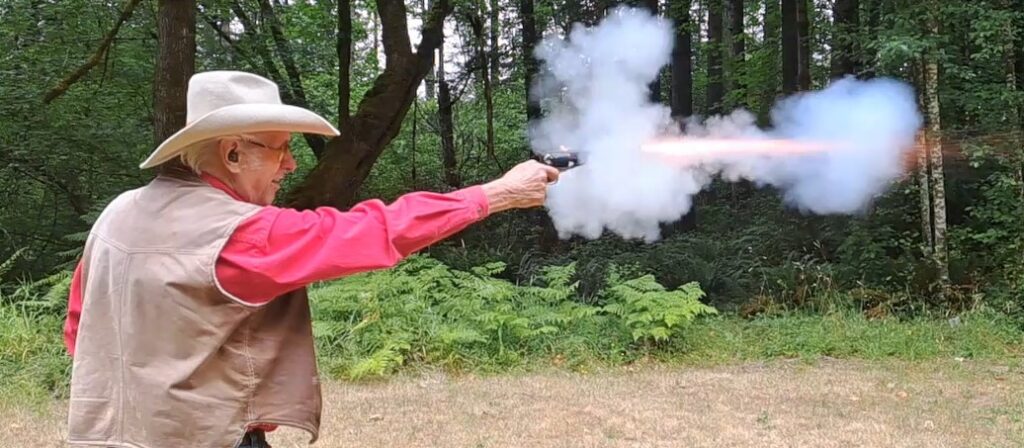
No shots were fired over a chronograph as yet with the .44 so I will borrow a note from another source just in case you are curious. Those others used 30 grains of FFFg GOEX under a 148-grain round ball and got approximately 820 feet per second with it. Perhaps we can estimate a velocity of 750 feet per second with the loads that I used, which had either 25 or 28 grains of the FFFg powder. That is just a guess and maybe I can verify it later.
Next, I’ll tell you about the loads I tried with the Hornady round balls. Actually, these were fired first and I was at least just as impressed with them as I was with the paper cartridges. First, the .451” Hornady swaged balls loaded very easily and they were rammed down over 25 grains of FFFg powder. After lubing the chamber mouths with the Vigilante lube, the nipples were capped and all six shots were fired at a paper target. Those shot very well and they grouped just a bit higher than the loads with the 28-grain powder charge. One reason, perhaps, for hitting higher is because they are slightly slower, therefore they have a longer barrel time (that is time spent inside the gun’s barrel) which allows recoil to raise the muzzle before the bullets exit on their way to the target. That could be easily checked by going back to the range, posting another target, and loading the gun with 28 or 30 grains of powder while using the same Hornady balls.
In my opinion, all of the shooting I’ve done so far with this early copy of the 1860 Army has been good and, in all likelihood, it should improve. That would certainly keep me happy. So, I’ll keep on trying small changes in the loading, perhaps getting the mold for the conical bullet from Eras Gone, like I mentioned, as well as getting the paper cartridge kit for the .44 from Guns of the West. Once those things are done, I hope you can stand to read another story.
For now, I’ll keep shooting with the round balls, trying more powder but mainly just to enjoy the practice. I have everything I need for now, including a fine cross-draw holster that Allen Cunniff made for me. This gun has a strong “Quigley” influence because of where I found it in addition to the gun’s serial number as well as the role it played in the movie.



